The shifting dynamics of modern family life, particularly in the context of housing, reveal a growing complexity in intergenerational relationships. Increasingly, adult children—termed the "boomerang generation"—are moving back in with their parents, driven by economic pressures such as high property prices, stagnant wages, and insufficient affordable housing options. Recent surveys indicate that a fifth of this demographic in the UK is now in their thirties, with many parents expressing a degree of contentment amidst their offspring’s return, though the latter often view it differently.
This phenomenon occurs against a backdrop of a severe housing crisis, particularly acute in urban areas. Cities like London have seen property values skyrocket at a pace that far exceeds wage growth, rendering home ownership a distant prospect for many. A stark contrast is evident when examining the housing crisis in comparison to other major cities around the globe, such as Dublin, Sydney, and New York, where the same trends of rising prices and stagnant incomes persist. The resulting housing shortage has become intertwined with political discourse, ultimately affecting economic confidence and even birth rates, as couples postpone family formation amid financial insecurity.
Socially, this crisis fosters a "zero-sum" mindset among younger demographics, who are increasingly sceptical about the viability of upward mobility. Research from Harvard suggests that urban residents are more prone to feeling trapped in a competitive societal framework where advancement seems contingent on the misfortune of others. These sentiments have echoed through the political landscape, influencing voting behaviours, such as the rise of populist movements in Canada and Europe that capitalise on housing-related discontent.
The implications of inadequate housing extend beyond immediate economic woes; they reshape societal interactions and family structures. Wealth disparities within generational cohorts have become starkly pronounced. While some millennials have benefitted from familial financial assistance—dubbed the "Bank of Mum and Dad"—to secure property, others find themselves hamstrung without such support. This dynamic not only deepens existing inequalities but also threatens the solidarity that once characterised the millennial generation.
As the housing landscape evolves, so do the potential solutions. Suggestions abound, including liberalising building regulations, repurposing commercial properties for residential use, and promoting higher-density housing developments. The calling for innovative designs has grown louder, with advocates like architect George Clarke highlighting a decline in housing quality over the past century. Clarke champions a well-rounded approach focused on sustainable and aesthetically pleasing homes, reflecting a necessary shift in public sentiment that contrasts sharply with the historical opposition to new housing—often termed “Nimbyism”—which stems from a distrust in the quality of new developments.
Furthermore, easing the downsizing process for older homeowners, who may wish to move to smaller properties, could significantly relieve market pressure. In the UK, approximately 1.4 million over-65s are reportedly interested in downsizing, a move that could release substantial housing stock back into the market. Moreover, the current government's ambition to increase housing supply, with a commitment to building 1.5 million new homes, is noble, but the reality is complicated by bureaucratic delays and evolving safety regulations that slow progress.
Without addressing the root causes of the housing crisis, the generational divide will only deepen, exacerbating feelings of disenfranchisement among the young. The situation underscores the urgency of elevating housing as a critical governmental priority, as its implications extend far beyond simple economic measures; they encompass the very fabric of family life and social equity. If a resolution remains elusive, the consequences will reverberate throughout society, hindering personal aspirations and perpetuating cycles of inequality that threaten the stability and cohesion of future generations.
Reference Map
- Paragraphs 1, 2, 3, 4, 6, 7, 8
- Paragraphs 1, 2, 5, 6
- Paragraph 5
- Paragraph 4
- Paragraph 2, 6
- Paragraphs 4, 5, 7
- Paragraphs 1, 4, 5
Source: Noah Wire Services
